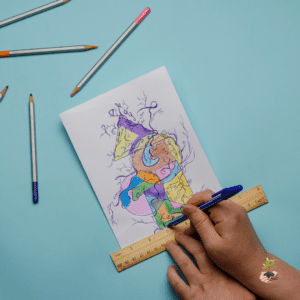Art therapy : An Introduction
Art therapy is a form of counselling that uses various art materials and creative techniques to explore emotions, experiences, and behaviours. This therapeutic approach is useful for people of all ages, including adults and children. In this blog post, we’ll discuss the benefits of art therapy, how it works, and how it might benefit various conditions.
Art therapy has been proven to be effective for those who struggle to verbalise their thoughts and feelings. By using different art materials, people can explore their emotions in a safe and non-judgmental space. This approach encourages the expression of feelings that may have been suppressed, which can help individuals to process and work through their emotions in a healthy way.
Here are some of the mental health conditions that may benefit from art therapy:
Anxiety Disorders – Art therapy can be helpful for people with anxiety disorders such as generalised anxiety disorder, social anxiety disorder, and panic disorder. It provides a way to express and manage anxious thoughts and emotions.
disorder, and panic disorder. It provides a way to express and manage anxious thoughts and emotions.
Depression – Art therapy can be a helpful tool for individuals experiencing depression. The creative process can provide a sense of purpose and accomplishment, which can help to combat feelings of hopelessness and low self-esteem.
Post-Traumatic Stress Disorder (PTSD) – Art therapy can be beneficial for people who have experienced trauma, including those with PTSD. Art therapy can help to process traumatic experiences and reduce symptoms such as anxiety and flashbacks.
Eating Disorders – Art therapy can be helpful for individuals with eating disorders such as anorexia, bulimia, and binge-eating disorder. It can provide a way to express and explore difficult emotions related to body image and self-esteem.
Substance Use Disorders – Art therapy can be used as a tool to support individuals in recovery from substance use disorders. It can help to reduce stress and anxiety, provide a sense of purpose and accomplishment, and provide a way to express difficult emotions.
Art therapy can be helpful for many other mental health conditions, including schizophrenia, bipolar disorder, and borderline personality disorder.
As you may have noticed, one of the primary benefits of art therapy is its ability to enhance self-awareness. By engaging in the creative process, people can gain a better understanding of their inner selves, including their thoughts, feelings, and beliefs.
The art therapist serves as a guide throughout the therapy process. They may provide prompts or ask questions to help the client explore their emotions and experiences. In addition, the therapist may help the client to interpret their artwork and identify patterns or themes that emerge. This approach can help the client to gain insight into their thoughts and emotions.
Art therapy can be particularly beneficial for children, who may not have the language skills or vocabulary to express their feelings verbally. Through art, children can communicate their emotions and experiences in a safe and non-threatening way. This approach can help children to build self-esteem and develop coping skills.
In conclusion, art therapy is a powerful form of counselling that can be beneficial for people of all ages. It offers a safe and creative way to explore emotions and experiences and can help individuals to gain insight into their inner selves. It is important to work with a qualified art therapist who can help to tailor the therapy to your specific needs and goals. They can also help you to integrate art therapy into a comprehensive treatment plan with other therapies and supports.
Thank you for reading our post on art therapy. We hope it has helped you understand the benefits of art therapy and the different ways it can help people. If you have any questions or concerns, please contact us at 08 87251843. We are always happy to help!
Citations:
Malchiodi, C. A. (2007). The art therapy sourcebook. McGraw Hill Professional.
Gantt, L., & Tinnin, L. W. (2002). Handbook of art therapy. Guilford Press.
Slayton, S. C., D’Archer, J., & Kaplan, F. (2010). Outcome studies on the efficacy of art therapy: A review of findings. Art Therapy, 27(3), 108-118.